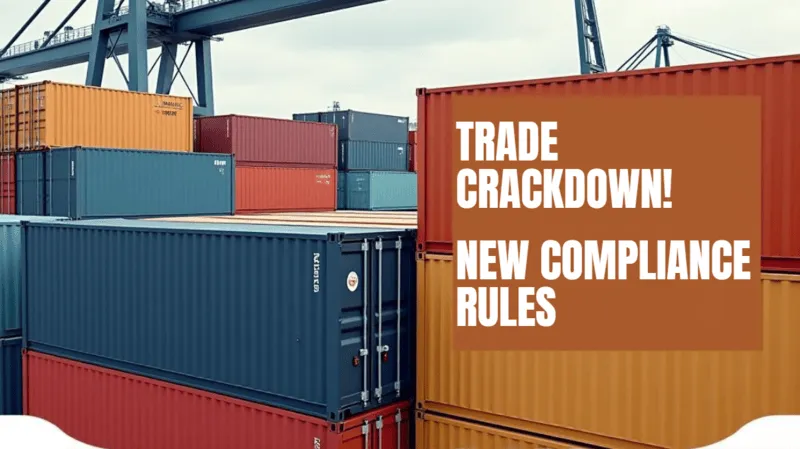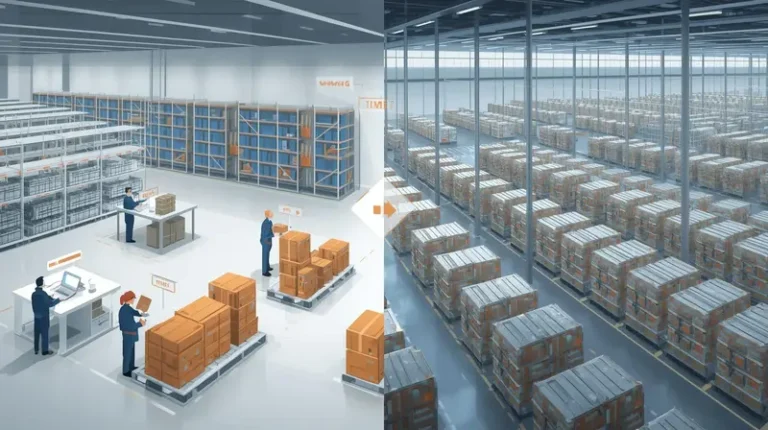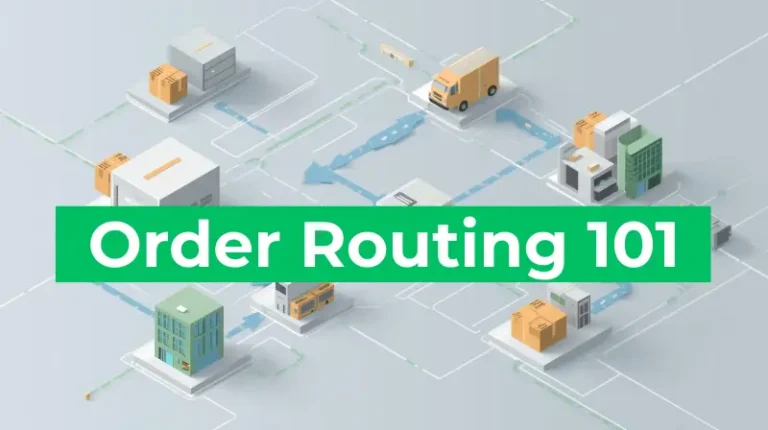“Trade Enforcement” Crackdown: New Rules that Could Kill Your Ecommerce Business

Last updated on August 14, 2025

In this article
 11 minutes
11 minutes
- Why The Pressure Is Rising (And Why Ecommerce Feels It First)
- The Five Most Common Potholes I See In 2025 (And How They Escalate)
- What Actually Happens When You’re Flagged (Beyond The Fine Print)
- DDP: Keep It, Fix It, Or Sunset It?
- The Practical Compliance Stack (What High-Performing Merchants Are Already Doing)
- The Omnichannel Wrinkle Most Teams Miss
- Logistics Strategy As A Compliance Strategy
- A 30-Day Sprint To De-Risk (Without Pausing Growth)
- The Mindset Shift That Separates Survivors From Strugglers
- Frequently Asked Questions
Trade rules used to be a background task. In 2025, they’re a front-of-house risk. Customs is asking harder questions. Penalties are steeper. And the playbook that worked when duties were low and parcel flows were lightly scrutinized? That playbook is retired.
I’m speaking as a logistics operator who works with ecommerce brands every day. The short version: enforcement is up, tolerance for “close enough” is down, and the burden of proof sits squarely with importers and their vendors. Let’s review how tariff policy, country-of-origin rules, DDP flows, and forced-labor screening converge, and what smart teams are doing now to reduce risk without slowing growth.
Why The Pressure Is Rising (And Why Ecommerce Feels It First)
Multiple forces are pushing enforcement to the top of the agenda this year:
- Tariff exposure is higher. Broader and/or higher duties increase the incentive to under-value or misclassify, and regulators respond by tightening audits, detentions, and penalties.
- Country-of-origin (COO) is decisive. Origin dictates duty rate and eligibility under trade programs. Transshipment and “last-touch” assembly to disguise origin are specific enforcement targets.
- De minimis scrutiny is real. Small parcels are no longer invisible; regulators are watching for patterns that look like duty avoidance through under-valuation or routing.
- Forced-labor rules (e.g., UFLPA) bite. If CBP suspects a link to forced labor in the supply chain, they can detain shipments until you prove otherwise. For seasonal brands, a multi-week detention can be fatal to margin and cash flow.
- Data analytics at the border. Customs systems flag anomalies: repeated “just under” values, implausible tariff codes for the product type, and IORs with inconsistent histories.
For ecommerce, the pain shows up faster: detention of a few containers, a batch of small parcels flagged, or a post-entry demand for duties/penalties can erase a quarter’s profit. Even if you clear it up, the operational whiplash (stockouts, customer delays, returns surge) lingers.
Slash Your Fulfillment Costs by Up to 30%
Cut shipping expenses by 30% and boost profit with Cahoot's AI-optimized fulfillment services and modern tech —no overheads and no humans required!
I'm Interested in Saving Time and MoneyThe Five Most Common Potholes I See In 2025 (And How They Escalate)
1) Misclassification (the wrong HTS code)
It often starts innocently, copying a competitor’s code, reusing a legacy code, or “choosing the lower rate” when two codes seem plausible. When the rate delta is large, auditors assume motive.
How it escalates: Repeated misclassification can trigger penalties, prior-entry reviews, or a full audit. In worst cases, it becomes a False Claims Act issue (government alleging underpayment of duties over time).
What to do instead: Build a defensible classification file for each SKU: product specs, composition, function, classification logic, and ruling references. Require supplier spec sheets. Re-review codes when products change materials or features.
2) Undervaluation (declaring less than the true transaction value)
Under pressure, some suppliers propose “commercial” and “customs” invoices with different values, or omit “assists” (molds, artwork, free components you provide) from valuation.
How it escalates: If discovered, CBP (Customs and Border Protection) can assess duties on the real value plus penalties and interest. Repeat issues risk referral to the DOJ or civil False Claims Act (FCA) action. Banks and marketplaces also get spooked by headline violations.
What to do instead: Document the full consideration paid for the goods and include assists where applicable. Align finance, procurement, and logistics so the customs value precisely matches your books.
3) Country-of-origin errors (and transshipment)
Relabeling or “light assembly” in a third country doesn’t necessarily change origin. If the COO is wrong, the duty rate and program eligibility are wrong.
How it escalates: CBP can detain, demand proof of substantial transformation, and assess back duties. If they see intent, penalties rise.
What to do instead: Map your product’s transformation steps. Keep supplier affidavits and manufacturing records. When in doubt, ask a broker or attorney for a written origin determination.
4) DDP flows with opaque importers of record
Delivered Duty Paid (DDP) makes for a frictionless customer experience, but introduces blind spots. If a logistics intermediary is the Importer of Record (IOR) for many small parcels, you need to know exactly how they declare value, classification, and origin.
How it escalates: If the IOR under-declares or uses suspect codes, your parcels get detained or returned. Even if the IOR is legally liable, your brand takes the hit with customers and marketplaces.
What to do instead: Demand transparency from any DDP partner: who is IOR, what values/codes are used, and how compliance is monitored. Consider shifting to bulk import as your IOR (pay duties cleanly once), then fulfill domestically for speed and predictability.
5) Forced-labor concerns (UFLPA and beyond)
If any component is suspected of being made with forced labor, CBP can detain it. The hard part: the presumption flips, you must prove your goods are clean.
How it escalates: Weeks of detention, missed sales windows, and, in some cases, denial of entry. Apparel, textiles, electronics accessories, and categories with cotton or polysilicon content are frequent targets.
What to do instead: Collect supplier attestations and traceability data down to raw materials where feasible. Maintain a dossier you can furnish quickly if asked (bills of materials, chain of custody, and audit summaries).
What Actually Happens When You’re Flagged (Beyond The Fine Print)
Let’s demystify the play-by-play:
- Administrative delay: CBP requests information or issues a detention notice. Meanwhile, inventory is stuck.
- Clock starts: You provide documents within a short window. If you scramble for proof, your ops team scrambles too.
- CBP decision: Release, rework, re-export, or seizure, plus potential duty adjustments.
- After-action: Even if released, your IOR is put on a watch list; future entries see more scrutiny.
- Financial echo: Freight sits longer (demurrage/detention), promotions slip, cancellations rise. Your returns team gets slammed weeks later.
The tangible cost is bigger than the duty bill: missed velocity, customer trust, and internal time. That’s why prevention wins the ROI contest every time.
Looking for a New 3PL? Start with this Free RFP Template
Cut weeks off your selection process. Avoid pitfalls. Get the only 3PL RFP checklist built for ecommerce brands, absolutely free.
Get My Free 3PL RFPDDP: Keep It, Fix It, Or Sunset It?
DDP shines for CX: no surprise charges, faster door-to-door. The problem isn’t DDP itself; it’s opaque DDP. If you can’t audit the IOR’s declarations, you’re borrowing risk at high interest.
Decision framework:
- Keep DDP if you can fully audit values, codes, and COO, and your categories are low-risk.
- Fix DDP by moving IOR to your entity (or a transparent partner), with your codes and values, and pre-agreed documentation standards.
- Sunset DDP for high-risk lines and import in bulk to U.S. facilities you control; ship domestically for reliability.
A lot of brands are landing on a hybrid: DDP for low-risk SKUs and bulk import for everything seasonal or compliance-sensitive.
The Practical Compliance Stack (What High-Performing Merchants Are Already Doing)
Think of this as your operating system for 2025. It’s not glamorous, but it’s how you keep selling when others get sidelined.
1) Governance: make someone the owner
Assign a trade compliance owner, often in ops or finance, with authority to set policy and say “no” when shortcuts are proposed. Publish a one-page policy: classification rules, valuation requirements (including assists), COO standards, and who can approve exceptions.
2) Product data discipline
Create (and maintain) a spec file for each SKU: materials, function, key dimensions, use case. Tie that to your HTS justification, COO evidence, and any rulings or broker memos. When product changes, the spec and code get reviewed. No exceptions.
3) Broker and partner alignment
Choose brokers who explain their reasoning and document it. Ask your freight forwarders and parcel partners how they monitor compliance. If anyone suggests “we can lower your duty with a different code,” you’ve found a weak link.
4) Documentation muscle
Keep clean records for five years: invoices, packing lists, purchase orders, payment proofs, supplier declarations, bills of lading, and correspondence. For UFLPA-sensitive goods, maintain traceability artifacts up front instead of chasing them later.
5) Internal controls and audit rhythm
Implement a pre-filing review on risky entries (new SKUs, new suppliers, tariff-sensitive lines). Run a quarterly mini-audit: sample 20 – 50 entries, verify codes/values/COO, and fix upstream root causes. Audit findings go to leadership, not to shame, but to fund fixes.
6) Sourcing strategy that respects reality
If duty rates spike on a core line, don’t just tweak codes; re-evaluate sourcing. Consider nearshoring or alternate suppliers with a cleaner COO and better documentation habits. Build that analysis into your gross margin planning, not as a last-minute emergency.
7) Plan for the worst (because it’s cheaper than the worst)
Draft a detention playbook: who compiles documents, what proof you provide for value/COO, what you’ll concede quickly to get goods released, and when you escalate to counsel. When hours matter, the team needs a script.
8) When to call a lawyer (and when to self-disclose)
If you discover past underpayments or suspect a systemic error, consider a voluntary disclosure through counsel. Penalties can be substantially reduced when you come forward first. This is not a sign of weakness; it’s how sophisticated companies fix problems before they become catastrophes.
The Omnichannel Wrinkle Most Teams Miss
Marketplace rules are converging with trade enforcement. Some platforms increasingly require accurate COO disclosure and will suspend listings that appear non-compliant. Meanwhile, retailers (B2B) push import reps and origin attestations into vendor standards. Translation: your sales channels are becoming compliance checkpoints. If you centralize product truth (specs, codes, COO, compliance docs), you’ll satisfy both customs and channels, and you’ll do it once.
Logistics Strategy As A Compliance Strategy
How you fulfill orders can raise or lower risk:
- Bulk import + domestic fulfillment reduces customs touchpoints and concentrates documentation into fewer entries you can control and defend. It also stabilizes lead times and avoids consumer-facing customs delays.
- Distributed inventory (multiple U.S. nodes) shortens zones and speeds delivery, but requires tighter inventory control and returns routing. Make sure your WMS/3PL can track lots/serials if you need that for audits.
- Returns processing should include basic QC and disposition rules. If you re-export returns or do cross-border returns, align those flows with customs filings to avoid mismatches.
Light Cahoot note: in our network work, we see brands move from risky DDP to bulk import with domestic 1 – 2 day coverage. It’s not just a shipping speed upgrade; it’s a compliance posture upgrade. You consolidate exposure, standardize documentation, and get predictable operations for peak.
Scale Faster with the World’s First Peer-to-Peer Fulfillment Network
Tap into a nationwide network of high-performance partner warehouses — expand capacity, cut shipping costs, and reach customers 1–2 days faster.
Explore Fulfillment NetworkA 30-Day Sprint To De-Risk (Without Pausing Growth)
You don’t need a six-month overhaul to be safer by next month. Here’s a pragmatic sprint:
Week 1: Map the risk
- List the top 50 SKUs by revenue. Confirm codes, COO, and values.
- Flag sensitive materials (cotton, polysilicon) and high-duty categories.
- Identify DDP lanes and who is the IOR.
Week 2: Fix the easy stuff
- Correct obvious misclassifications; document logic.
- Update invoices to include assists where missing.
- Get supplier origin attestations for flagged SKUs.
Week 3: Partner alignment
- Brief your broker and forwarder on your policy; ask for their ideas.
- If DDP is opaque, demand transparency or begin shifting those SKUs to bulk import.
Week 4: Institutionalize
- Publish your one-pager compliance policy and assign an owner.
- Schedule the quarterly mini-audit and a tabletop “detention drill.”
- Add compliance checkpoints to your new product introduction (NPI) process.
You’ll come out with cleaner data, aligned partners, and a plan if a shipment gets flagged. That’s real insurance you can feel.
The Mindset Shift That Separates Survivors From Strugglers
The winners don’t treat customs as a form to fill; they treat it as an operating capability. They build product truth, choose partners who document, and rehearse the bad days so they aren’t bad for long. They also use trade reality to make better business calls, where to source, what to price, and which SKUs deserve expansion.
And they don’t wait for a notice of action to get with the program. They act now because the cheapest time to fix compliance is before anyone asks.
Frequently Asked Questions
What is driving the increase in trade enforcement in 2025?
Rising geopolitical tensions, tariff disputes, and renewed focus on supply chain transparency have prompted regulators to increase enforcement actions. Agencies are targeting misclassification, false country-of-origin labeling, and duty evasion more aggressively.
Which violations are ecommerce sellers most at risk for?
Common pitfalls include incorrect HTS codes, undervaluing shipments to avoid duties, failing to update country-of-origin information, and ignoring new tariff requirements. Even small oversights can trigger fines or shipment seizures.
How can ecommerce brands reduce compliance risk?
Maintain accurate product data, regularly review tariff classifications, and ensure all suppliers follow current labeling and documentation requirements. Investing in compliance audits and training can help prevent costly mistakes.
What happens if a shipment is found non-compliant?
Consequences range from delayed deliveries and financial penalties to the loss of import privileges. In severe cases, businesses can face reputational damage and long-term operational disruptions.
How does Cahoot help sellers stay compliant?
While Cahoot does not act as a customs broker, its fulfillment network and technology are built to support sellers’ compliance needs, including accurate order data, transparent shipping documentation, and partnerships with trusted logistics providers. Our network of freight forwarders are all experts and can consult with sellers one-on-one to clarify any questions they may have.

Turn Returns Into New Revenue





